Welcome to the enchanting world of Boseong, a captivating destination nestled amidst the picturesque landscapes of South Korea. Renowned for its breathtaking green tea plantations and a rich cultural heritage, Boseong offers a delightful escape into nature’s embrace. From exploring the vast tea fields that have stood the test of time to discovering the serene shores of Yulpo Beach, this journey promises a harmonious blend of tranquility and adventure. Join us as we delve into the wonders of Boseong, where each step unravels a story of ancient traditions and natural beauty. For this article, rather than giving an uniform itinerary, I would like to recommend selecting a few spots and move around. They are just few minutes away by car. Now let’s get into this!
Boseong Tea Plantation (Tea Garden)
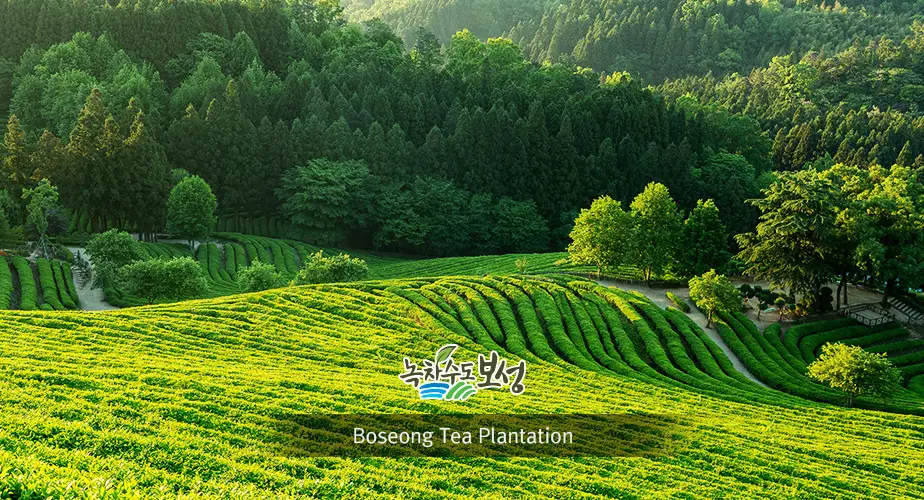
Nestled in the picturesque region of Joellanam-do, South Korea, Boseong boasts an enchanting landscape of green tea plantations sprawled over approximately 1.5 million pyeong. Among the many tea estates, Daehan Tea Company in Boseong stands out as the only tea theme park in the country, inviting visitors to delve into the history and beauty of Korean tea.
Historically renowned as the birthplace of Korean tea, Boseong’s geographical location at the far end of the Korean peninsula blesses its tea fields with an ideal climate, close proximity to the sea, and the perfect balance of temperature and humidity. The esteemed Daehan Tea Company has been cultivating tea since 1957, making it the oldest tea plantation in Korea, and second only to Jeju Island in size. The quality of the tea produced here is widely regarded as the best in Korea, attracting tea enthusiasts and connoisseurs from all corners of the globe.
Nestled at the foot of a mountain overlooking Bongsan-ri in Boseong-eup, the plantation spreads across a vast flatland of approximately 30,000 pyeong. Upon entering the estate, visitors are greeted by the refreshing sight of towering Japanese cedar trees, their size reminiscent of electric poles, imparting a sense of tranquility and freshness to the surroundings.
Address: 763-65 Nokcha-ro, Boseong-eup, Boseong-gun
Phone: 061-852-4540
Yulpo Tourist Complex
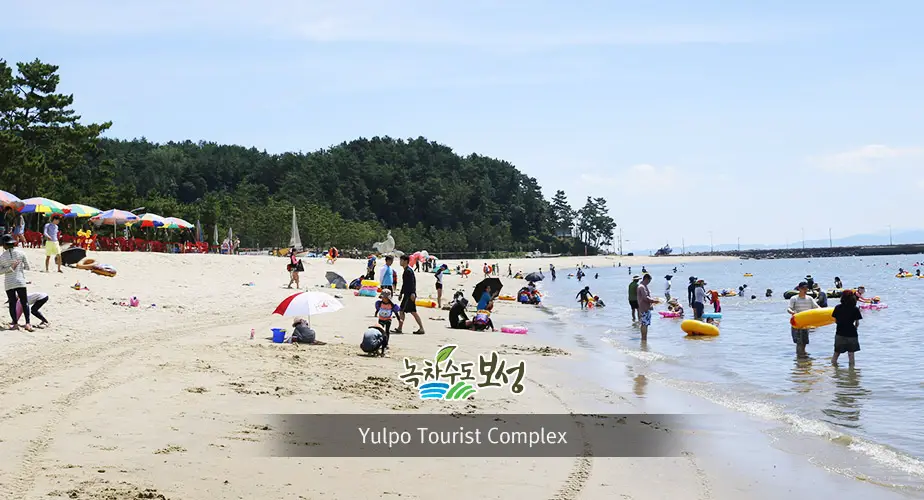
A short distance from the tea plantations lies the Yulpo Tourist Complex, a haven for beach lovers and those seeking relaxation by the tranquil Deungnyangman Bay. Yulpo Beach welcomes visitors with its silvery sand and the gentle embrace of black pine trees, creating a serene oasis that feels more like a secluded lake than a bustling beach. The shallow waters are perfect for sea bathing and provide an inviting escape from the heat of summer.
But Yulpo’s allure extends beyond its sandy shores. The Yulpo seawater green tea spa, nestled alongside the pine tree beach, offers a unique experience of relaxation and rejuvenation. This one-of-a-kind spa combines seawater from a 120-meter-deep bedrock with Boseong green tea, providing a refreshing retreat for tired bodies and souls. The spa’s healing properties are believed to benefit those with high blood pressure, arteriosclerosis, arthritis, and neuralgia, while also protecting and nourishing the skin.
For those seeking aquatic adventures, the Yulpo seawater pool beckons with its fun-filled outdoor swimming facilities. Children and adults alike can frolic in the clean seawater while enjoying attractions like an 81-meter tunnel tube slide, a playful pirate ship, and a flowing pool.
Jeamsan Mountain Recreational Forest
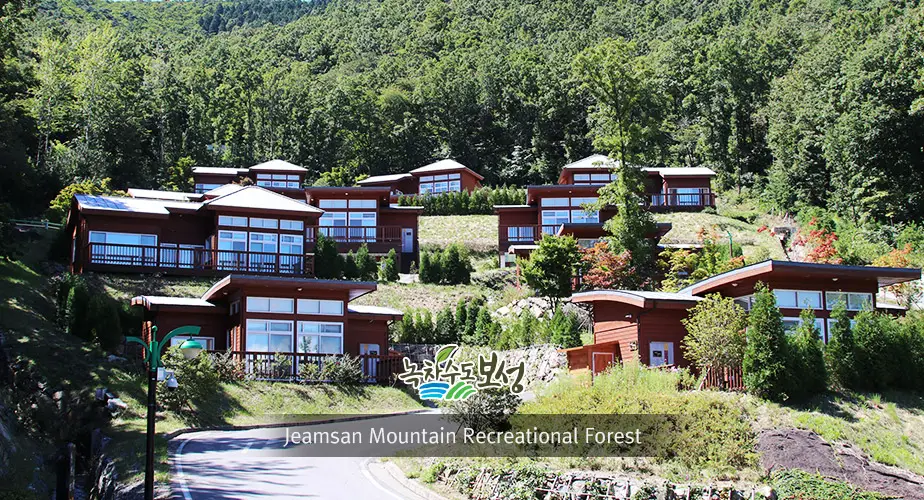
For nature enthusiasts and hikers, a visit to Jeamsan Mountain Recreational Forest is a must. Rising 807 meters above sea level, this divine mountain has long been revered as a place of prayer during times of national hardship and draughts. On clear days, visitors are rewarded with stunning views of Mudeungsan Mountain and the crystalline waters of Deungnyangman Bay.
At the foot of Jeamsan Mountain lies the Jeam Recreation Center, a propitious site where a prime minister’s grave symbolizes the enduring spirit of Jeam. The recreational forest, equipped with various conveniences like parking lots, camping sites, log cabins, and modern condominiums, caters to every explorer’s needs.
Hikers can embark on a memorable 10.5-kilometer return trip to the peak of Jeamsan Mountain, leading them to awe-inspiring spots like the Jeamsan royal azalea colony, Sajasan (Mibong Peak), Illimsan Mountain, Hanchijae, and Yongchu Valley. Each season brings its own charm to the mountain; spring showcases a splendid display of azalea and royal azalea, summer treats visitors to inviting pools and valleys, while autumn offers a spectacle of falling leaves, and winter draws hikers with its snowy scenes and a captivating flame grass colony at the mountaintop.
The Illimsan Royal Azalea Festival, held in early May, dazzles visitors with a crimson sea of blooms, creating a perfect setting for a spring picnic. The enchanting scenery, seen from the summit, includes sweeping views of Sajasan, Honamjeongmaek, Cheongwansan Mountain, Mudeungsan Mountain, and the picturesque coastal road stretching from Yulpo Beach in Deungnyangman Bay to the Anyang-myeon coastline.
To round off the journey, hikers can descend through the green tea plantation, the Hyeseong Bird Garden, and the Geumcheon Seochogyo Bridge, savoring approximately three hours of nature’s embrace.
In Autumn, falling leaves create a spectacular view and in Winter, hikers rush in to see the snow scene and the flame grass colony at the top of the mountain.
Parking Fee: KRW 3,000/car less than 35-seater, KRW 5,000/car over 35-seater
Address: 330 Daesan-gil, Ungchi-myeon, Boseong-gun
Inquiries: 061-852-4434, 850-8701
Bibong Dinosaur Site

Venturing towards Seonso Beach in Bibong-ri, curious explorers will find the captivating Bibong Dinosaur Site. This remarkable location holds countlessly many dinosaur eggs discovered in nests dating back to the Cretaceous period in the Mesozoic Age. Here, visitors can observe around 10 dinosaur nests and nearly 100 dinosaur eggs, with some measuring up to 1.5 meters, while individual eggs range from 9 to 15 centimeters in size. The eggshell thickness, ranging from 1.5mm to 2.5mm, hints that these eggs may have fossilized after hatching.
Beyond its fascinating paleontological significance, the Bibong Dinosaur Site offers valuable evidence about the habitats and behaviors of dinosaurs. This treasure trove of information has earned it the designation of a natural monument, preserving its ancient secrets for generations to come.
Daewonsa Temple
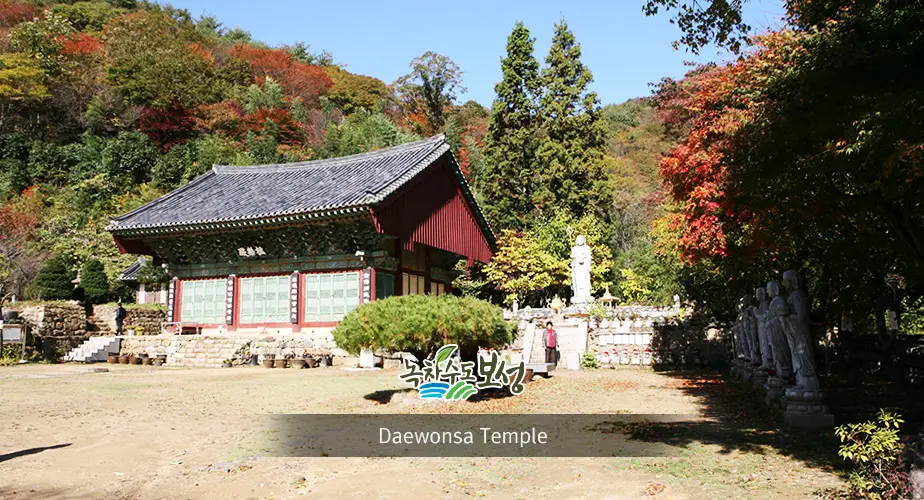
Daewonsa Temple, an architectural gem, gazes southward with the Cheonbongsan Mountain peak slightly to the right. Although some of its ten buildings were tragically lost during the Lushun incident, the hall of Paradise was miraculously spared, retaining the temple’s spiritual essence.
Steeped in history, Daewonsa Temple has a long tradition dating back to the Silla Dynasty, and its establishment is credited to Adohwasang during the reign of King Jijung. Later, in the Goryeo Dynasty, Jeose Wonoguksa of Jogye contributed to its construction, while the Joseon Dynasty saw further expansion in the 43rd year of King Yeongjo’s reign.
The temple embraces nature’s beauty, especially during spring, when the cherry blossom trail springs to life. Every year, the cherry blossom tunnel attracts visitors with its ethereal beauty, creating a mesmerizing spectacle.
Illimsan Mountain
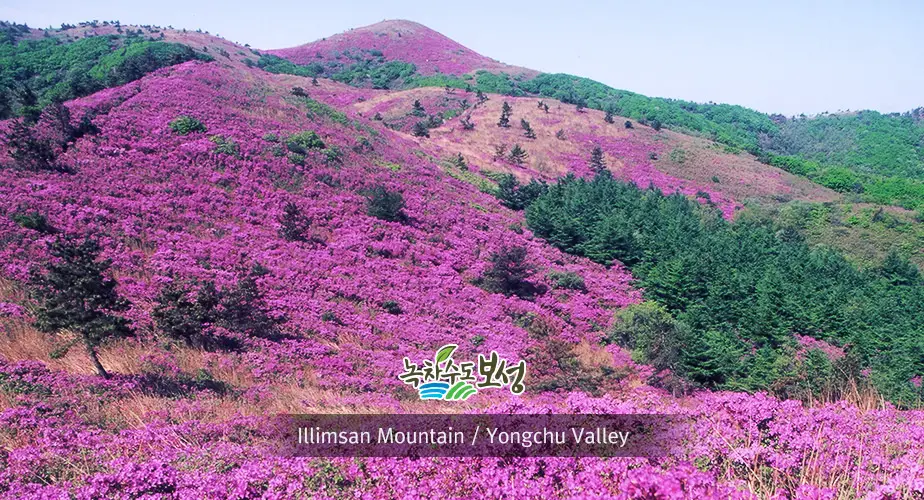
A jewel among the mountains, Illimsan Mountain, nestled between Ungchi-myeon and Hoecheon-myeon, unfolds an enchanting panorama. The royal azalea colony, sprawling over a vast field of more than one million pyeong, offers a breathtaking sight in early May when the Illimsan Royal Azalea Festival paints the mountain red.
The mountain’s two large valleys boast a wetland under the peak, where water cascades down the rocks in a spectacle reminiscent of a dragon ascending to the sky. The fragrance of Japanese cedar trees fills the air, adding to the allure of the surroundings. The mountain’s ridge, situated around one-fifth of the way up the peak, features a knee-length bamboo field, and the silver grass field near the summit presents a breathtaking view.
Visitors are rewarded with panoramic vistas from the mountain’s summit, offering glimpses of Sajasan and Honamjeongmaek, extending towards Jeamsan Mountain, as well as Cheongwansan Mountain in Jangheung-gun and Mudeungsan Mountain in the distance. The southeastern view reveals a captivating coastal road, stretching from Yulpo Beach in Deungnyangman Bay to the coastline of Anyang-myeon, Jangheung-gun, and the Boseongman Bay area.
The mountain trails, though relatively easy, offer a delightful trek through stunning landscapes. Most trails begin at Hanchi, on the border between Hoecheon-myeon and Ungchi-myeon. The descending trail leads past Illimsa Temple, the green tea plantation, Hyeseong Bird Garden, and the Geumcheon Seochogyo Bridge, enchanting hikers with nature’s splendor for approximately three hours.
Juamho Lake / Seo Jae-pil Memorial Hall
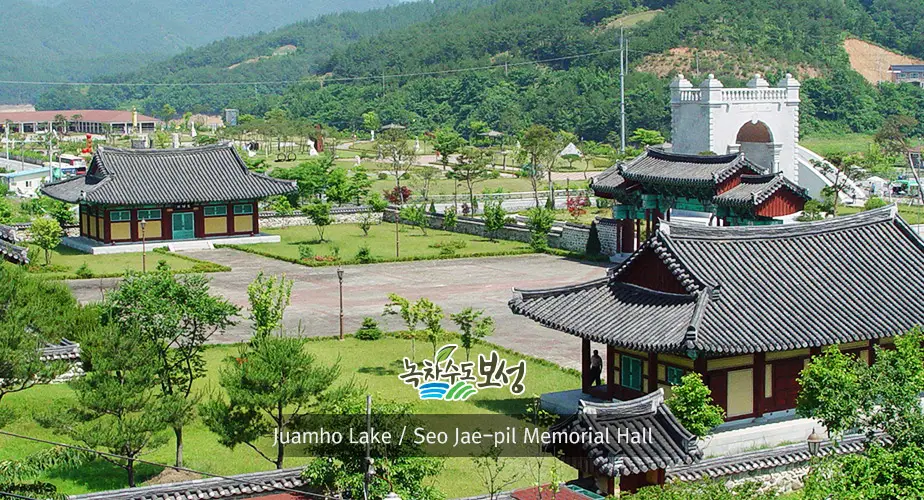
Amid the serene valley between Daegwang-ri and Gusan-ri in Juam-myeon, Suncheon-si, the Juam Multipurpose Dam created an expansive artificial lake, stretching across three cities and counties: Boseong, Suncheon, and Hwasun. Juamho Lake’s mesmerizing beauty unfolds in the surroundings, with the steel arch bridge forming an impressive and unique backdrop.
In this idyllic setting lies the Seo Jae-pil Memorial Park, a tribute to the life and achievements of Seo Jae-pil, born in Ganae Village, Yongam-ri, Mundeok-myeon. A prominent figure in Korean history, Seo Jae-pil played a crucial role in the Gapsin Reform of 1884 and later became the first Korean doctor in the United States. Upon his return to Korea in 1895, he founded the Tongnip Sinmun (Independence Newspaper) and championed the independence movement. His contributions to the nation’s freedom and modernization left a lasting impact.
The Seo Jae-pil Memorial Park offers an opportunity to explore the history and romance of rural life in the farming village where Seo Jae-pil was born. The park features an actual-sized model of Seoul Dongnimmun Gate and a sculpture park set amidst the picturesque landscape of Juamho Lake.
Boseong’s allure lies in its tranquil green tea fields, mesmerizing natural wonders, and historical treasures. A journey through Boseong is an invitation to discover the beauty of Korea’s rich culture, indulge in breathtaking scenery, and be captivated by the charm of this serene
Tea Museum of Korea
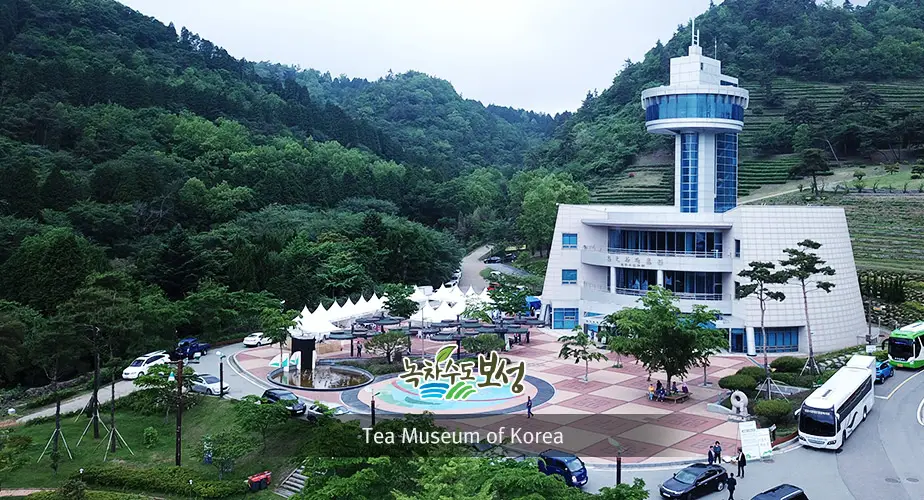
Nestled adjacent to the enchanting Boseong green tea plantation, The Tea Museum of Korea stands as a beacon of knowledge and appreciation for the art of tea. This captivating museum is dedicated to providing a wealth of information about tea, laying the foundation for the proper establishment, research, and dissemination of tea culture in Korea.
The museum is thoughtfully designed across three floors, each offering a unique perspective on the world of tea. The first floor houses the Tea Culture Hall, a space that invites visitors to explore the essence of tea and its significance in Korean culture. Here, guests can immerse themselves in the traditions, rituals, and stories that have woven tea into the fabric of Korean society.
Ascending to the second floor, tea enthusiasts embark on a journey through time in the Tea History Hall. This section of the museum showcases an impressive array of tea tools and artifacts, thoughtfully arranged in chronological order. The exhibits reveal the captivating evolution of tea and its profound impact on Korean history and culture.
For those seeking an experiential dimension, the third floor beckons with the Tea Life Hall. This interactive space allows visitors to delve deeper into the diverse and vibrant world of tea culture. Through hands-on experiences, guests can engage in tea ceremonies, taste different tea varieties, and gain an authentic appreciation for the art of tea-making.
The Tea Museum of Korea serves as a haven for tea enthusiasts, scholars, and curious minds alike. It fosters a rich environment for education, enabling visitors to learn, experience, and share knowledge about tea, with a particular focus on the revered Korean tea, including the famous Boseong tea. This cultural exchange platform celebrates the beauty of tea and its profound impact on the lives of people in Korea and beyond. Whether one seeks to deepen their understanding of tea’s historical significance or indulge in the pleasures of tea culture, The Tea Museum of Korea offers an enriching and enlightening experience that leaves visitors with a newfound appreciation for this time-honored beverage.
Location: 775 Nokcha-ro, Boseong-eup, Boseong-gun
A trip to Boseong is an invitation to experience the harmony of nature, culture, and history. The lush tea fields offer a serene retreat, where the scenic beauty calms the mind and nourishes the spirit. The cultural treasures, from traditional tea ceremonies to coastal traditions, provide a glimpse into the vibrant tapestry of Boseong’s heritage. Whether you seek to escape the urban clamor or immerse yourself in a world of breathtaking landscapes, Boseong stands ready to enchant you with its timeless allure. So, come and indulge in the green embrace of Boseong, where every moment becomes a cherished memory.
